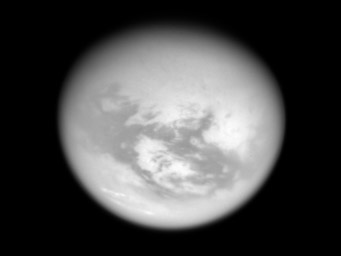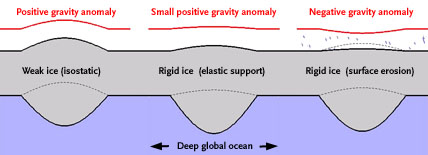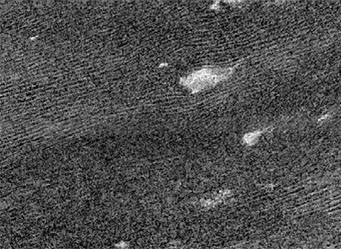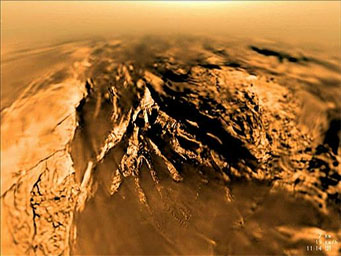By comparing the surface topography and gravity field of Saturn's big moon, researchers conclude that Titan must have a relative rigid, highly eroded ice shell.
One of the first things I learned in my geology classes, all those years ago, was the concept of isostasy. A low-density object (like an iceberg) floating in a higher-density fluid (like an ocean) will reach a point of buoyant equilibrium. The same holds true on Earth: continents and big mountain ranges maintain their loftiness by having deep, buoyant "roots" that extend into the upper mantle.

To human eyes the haze in Titan's atmosphere would completely hide its surface. But NASA's Cassini orbiter can glimpse the surface by taking images through near-infrared filters, as it did here in May 2007. Note the wispy clouds near the bottom of the disk. At radar wavelengths the atmosphere is completely transparent.
NASA / JPL / Space Science Inst.
After more than 90 flybys of Titan by the Cassini spacecraft, dozens of them at close range, planetary scientists have amassed enough detail about Saturn's big moon to compare its surface topography and its gravity field. If Titan's water-ice crust is in isostatic balance with the global ocean presumed to lie deeper down, the gravity field show modest increases over high-standing plateaus and mountain ranges.
But it doesn't. As Douglas Hemingway (a doctoral candidate at University of California, Santa Cruz) and three colleagues report in this week's Nature, there's a negative correlation between surface topography and the local gravity's strength.
"Normally, if you fly over a mountain, you expect to see an increase in gravity due to the extra mass of the mountain," notes Francis Nimmo (Hemingway's co-author and thesis adviser) in a UCSC press release. "On Titan, when you fly over a mountain the gravity gets lower. That's a very odd observation."

As Titan has cooled over time, freezing occurs at the base of its outer ice shell. If the shell is weak (left), it readily warps upward to balance the buoyant "root" at the base. A rigid ice shell (middle) warps somewhat less, but the gravity field measured from above is still somewhat positive. However, a rigid shell combined with surface weathering (right) gradually wears down upwarped topography yields a negative gravity signature. Click here to view a short video showing how these scenarios develop and evolve.
Douglas Hemingway
The best way to explain this, the team contends, is that surface topography has been partially eroded away, while the underlying low-density ice "roots" remain. To keep those huge buoyant masses from pushing themselves upward, Titan must also have an unexpectedly thick and rigid outer shell. Hemingway calculates that this rigid layer would need to be at least 25 miles (40 km) thick.

Cassini scientists estimate that dunes of ice particles cover about 13% of Titan, roughly equivalent to the area of Canada. This view shows the moon's Belet dune field. The dune crests, which appear dark in this radar image, are about 2 miles apart.
NASA / JPL
Moreover, the researchers suggest that lots of the topside topography must have been worn down over time — anywhere from 100 m to 1 km, depending on the rigid shell's thickness. Much of this must have occurred around Titan's midsection, where the present-day topography is generally higher.
All this erosion would help explain why the big moon has so few impact craters — and such vast expanses of dunes (made of ice particles, not sand) around its midsection.
This super-stiff exterior might also help dynamicists understand why Titan has an orbital eccentricity of about 0.03. If its crust has been flexing up and down for billions of years, due to tides raised by Saturn's powerful gravity, dissipating all that tidal energy should have circularized the orbit (e = 0) long ago.

The European Space Agency's Huygens probe dropped to the surface of Titan on January 14, 2005. During its147-minute plunge through the moon's thick, orange-brown atmosphere, it recorded this panorama of a surprising Earthlike scene, with river systems coursing down mountainsides to soft, sandy plains.
ESA / NASA / JPL / Univ. of Arizona
Hemingway and his colleagues offer three ideas to explain the crustal rigidity. It could arise from an outer shell rich in a kind of ice mixture called a clathrate or from a subsurface ocean infused with ammonia (allowing it to be colder without freezing). Or perhaps the moon's interior never completely separated into discrete layers, which would skew the gravity measurements.
Fortunately, more close flybys of Titan by Cassini are coming up, and these should improve the overall gravity map enough to help mission scientists sort out these possibilities.
 1
1
Comments
Randall Osczevski
August 30, 2013 at 4:23 pm
The second image shows parallel ridges that are interpreted as dunes, however they might actually be parallel melt troughs. There is a terrestrial analog. They look very much like the structures on the Ward Hunt Ice Shelf on the northern coast of Ellesmere Island in Canada's High Arctic. These are not dunes, but parallel structures formed when melt water is blown by the wind over centuries. It wouldn't be water on Titan of course, but the mechanism might be similar.
You must be logged in to post a comment.
You must be logged in to post a comment.